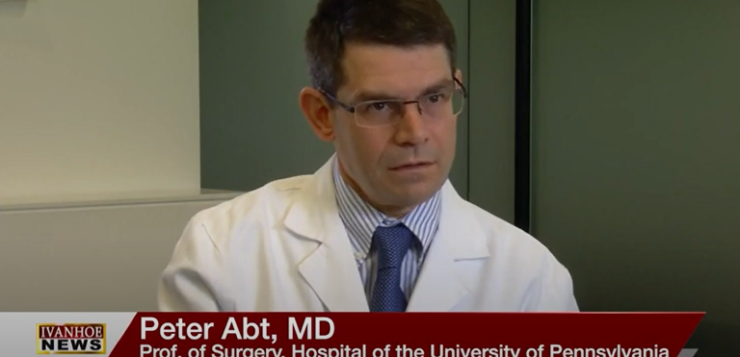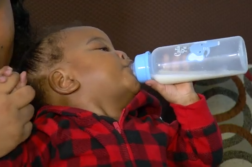Dr. Peter Abt, MD, Abdominal Transplant Surgeon, and Professor of Surgery and at the Hospital of the University of Pennsylvania, talks about a new protocol, called Liver Ex Vivo, that could potentially increase the number of organs available for patients in need.
Interview conducted by Ivanhoe Broadcast News in January 2022.
Can you give our viewers a sense of what kind of need there is for livers in the United States?
DR ABT: There’s quite a need. There’s probably about 2,000 people a year, approximately, who die on the waiting list waiting for a liver, and numerous others who could benefit but may not necessarily get listed because of how sick they are.
About how many liver transplants are performed in the United States every year?
DR ABT: It increases every year, but approximately seven to eight thousand liver transplants a year.
What are some other options for patients who are on that list and the liver doesn’t come through? Is there a similar option for people in need of a liver?
DR ABT: Most individuals on the waiting list are waiting for a deceased donor. However, the alternative is a living donor liver transplant. That’s where a friend or relative, or even sometimes, a stranger, gives you part of their liver. This is not done to the same degree as in kidney transplantation, but it is increasing in the United States. And that is just being initiated now. It’s really in its infancy.
How would that work? You say it’s just in its infancy. Is it just a couple of hospitals or a couple of organ systems where they’re participating?
DR ABT: So, this has mostly occurred within individual centers where they may have a pair that are incompatible. The swap occurs within the center. But UNOS, which is the United Network for Organ Sharing, has put together a pilot program to initiate swaps between donor and recipients in different centers. That is just getting off the ground right now.
The liver is kind of a unique organ, isn’t it? You mentioned that just a portion of the liver can be transplanted. Can you explain?
DR ABT: The liver is a unique organ in that it can regenerate, so, you can remove half to two thirds of somebody’s liver and give it to somebody else. That donor piece left in the donor will regenerate to the size that it’s able to support that donor.
UNOS is just beginning the pilot program. Is the University of Pennsylvania involved in that?
DR ABT: Yes.
What’s the role of the University of Pennsylvania in those?
DR ABT: So, there are a handful of transplant centers in the United States that are participating in this pilot program. What we will do is list incompatible pairs in this pilot program and then we’ll plan for exchanges.
Do you know how many universities are participating?
DR ABT: I think there are between eight and 15. But I’m not sure. This is really just getting off the ground now.
Can you explain what Ex Vivo is and how it would work for liver?
DR ABT: Yes. The idea is that an organ is placed on a pump device, and it’s given warm, oxygenated blood, or sometimes, just preservation solution. The goal is twofold. One is to help that organ work better in the recipient. Another goal is to make it last longer. So, when it’s outside the body, it can remain outside of the body longer and thus have better preservation and then, eventually, improve the quality of that organ with some type of intervention. But that’s looking forward to the future.
How much longer could that organ last on that perfusion system?
DR ABT: Right now, there are two liver devices that have recently been approved for use in the United States and they can be used for up to 24 hours.
You said there are two liver devices. Were you part of the clinical trial in the pilot program here?
DR ABT: Yes, the University of Pennsylvania was part of one of these pilot trials with one of the devices.
Can you explain a little bit more? How many patients were you able to do a transplant after having the organ on the machine?
DR ABT: So, it was a randomized trial. Organs were randomized to whether they were placed on the pump or not then, the organs were transplanted. The patients were followed up afterwards to see if the outcome of the transplant was better with the pump versus without the pump. And at Penn, we did approximately 15 patients.
What did you find?
DR ABT: In general, the organs perfused. That is, once they are placed in the recipient, they appeared much better. There is some evidence that they initially worked a little bit better when they were pumped.
What’s the next step and was that a phase one for this particular system?
DR ABT: I don’t know if we could call it a phase one. It’s a randomized trial. I would say it doesn’t have the same nomenclature as a drug trial. But the next step is to see if we can take organs that are turned down for transplant by all centers and place them on a pump to test them to make sure they’re functioning. That way, we look to make sure that they’re clearing acid, metabolizing glucose, and making bile. Then, we use them for transplant if they appear to be working well on the pump. That way, we, as physicians, will feel better assured that we can use an organ that will be successful.
What kind of an impact could this have on your field down the road?
DR ABT: In the short term, it probably means that we can use several hundred more livers a year for transplantation. These are organs that would have not been transplanted.
Long term, do you think there’s success with this?
DR ABT: Yes. I think, if successful, we’ll be able to expand the number of potential donors quite a bit. Then, there’s also the potential that we may be able to intervene on these organs while they’re on the pump whether some type of drug that will make them function better so that they’re more successful at the time of transplant.
Is there anything that you would want people to know about liver transplantation or the need for donation?
DR ABT: I would encourage everybody to consider signing up to be an organ donor. It’s really important. It makes a huge impact in patients’ lives.
END OF INTERVIEW
This information is intended for additional research purposes only. It is not to be used as a prescription or advice from Ivanhoe Broadcast News, Inc. or any medical professional interviewed. Ivanhoe Broadcast News, Inc. assumes no responsibility for the depth or accuracy of physician statements. Procedures or medicines apply to different people and medical factors; always consult your physician on medical matters.
If you would like more information, please contact:
Dan Fower
Sign up for a free weekly e-mail on Medical Breakthroughs called First to Know by clicking here




